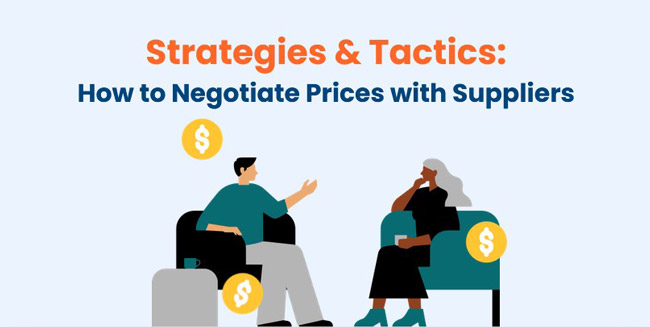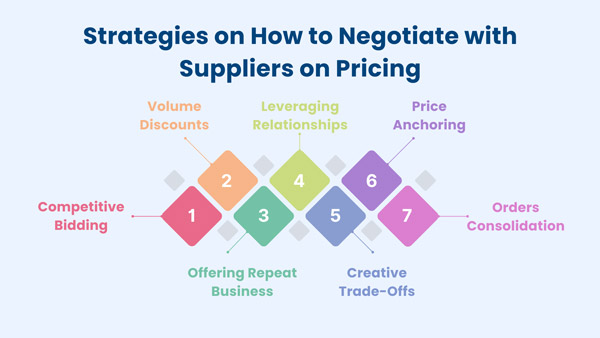Strategies & Tactics on How to Negotiate Prices with Suppliers
- Date:
- Author: SVI Content Team
- Share:
Negotiation is a fundamental aspect of achieving better prices in global sourcing. It involves a series of interactions and discussions between parties with the aim of reaching a mutually beneficial agreement.
A better product pricing can lead to great profitability. If you wonder how to negotiate price with supplier, this blog sure will offer you practical methods and tips for negotiation. It covers the parties involved in the process, what factors affect results, negotiation strategies and tactics and more.
Part 1. Understanding What Price Negotiation Is
Key Parties Involved in Price Negotiation
- Buyer: The buyer or the business owner represents the company’s interests in the negotiation process. They are responsible for defining the requirements, setting objectives, and evaluating potential suppliers. The business owner aims to secure the best deal that aligns with the company’s needs and budget.
- Supplier: The supplier or the factory is the party providing the products or services. They may be an existing supplier or a potential one. Suppliers seek to maximize their profits while maintaining a mutually beneficial relationship with the buyer.
- Vendor: The vendor acts as an intermediary between the buyer and the supplier. They facilitate the negotiation process, assist with contract negotiations, and ensure compliance with terms and conditions.
Factors Influencing Negotiation Outcomes
- Bargaining Power: The balance of power between the buyer and the supplier significantly impacts the negotiation outcomes. Powerful suppliers with unique products or services, a strong track record, or limited competition may have more leverage. On the other hand, buyers with multiple potential suppliers, large purchase volumes, or alternative sourcing options can negotiate from a position of strength.
- Relationship-Based Environment: Building and maintaining strong relationships with suppliers can influence negotiation outcomes. Positive supplier relationships can lead to preferential pricing, improved terms, and a better understanding of each other’s needs.
Part 2. What to Do Before Price Negotiation
When it comes to how to negotiate better price with supplier, through preparation is essential to maximize the chances of achieving the best prices before engaging in negotiation.
1. Evaluate Potential Suppliers
To negotiate effectively, it’s important to have a solid understanding of potential suppliers and their track records to make sure they are well-structured and meet quality standards.
To verify a supplier, conduct factory audits and comprehensive research to gather information about their reputation, delivery, quality control procedures, production capacity and capabilities. You may also assess compliance with industry standards, certifications, and financial stability.
Making sure your potential supplier is well fits your requirements can do you good. And having a backup of suppliers gives you the confidence to negotiate.
2. Setting Clear Objectives and Priorities
“Know what you want before you enter the room. That clarity is half the battle in negotiation.”
Having an organized plan and clear objectives are things that can give you confidence during negotiation.
Determine what you want to achieve from the negotiation process. This could include your target pricing, better payment terms, longer-term contracts, or value-added services. Prioritize your objectives based on their importance to your business. Consider factors such as the impact on profitability, cash flow, customer satisfaction, and overall strategic goals.
By clearly defining your objectives and setting your priorities, you can focus your negotiation efforts and communicate your requirements effectively to potential suppliers.
Part 3. Strategies on How to Negotiate with Suppliers on Pricing
Whether your aim is to secure better prices, establish favorable contract terms, or strengthen supplier relationships, the right approach to negotiation can make all the difference.
1. Competitive Bidding
Request quotes from multiple suppliers (at least 3) for the same product or service. This creates competition and encourages suppliers to offer their best possible price to win your business.
This approach puts pressure on suppliers to be competitive and transparent with their pricing, and it gives you options to compare.
2. Volume Discounts
Negotiate better pricing by committing to larger order quantities. The volume of purchasing orders will affect suppliers’ profitability. Therefore, suppliers are more likely to lower prices when they know they are guaranteed a higher volume of orders.
3. Offering Repeat Business
Show you have the possibility of placing future orders with large quantities. Having long-term cooperation is what businesses value. Suppliers, of course, are going to choose partners who can provide regular purchasing orders.
4. Leveraging Relationships
Taking advantage of relationships is one of the effective methods on how to negotiate lower price with supplier. If you and a supplier have established a partnership in the past, you may negotiate lower prices with it. The previous successful collaboration makes a good foundation for another deal. You show your trust and are willing to work with it once again, which is an appreciation by a supplier. So they are apt to give discounts to loyal clients.
5. Creative Trade-Offs
You can start the conversation about non-price terms (e.g., delivery schedules, packaging, payment terms) to make the deal more favorable without focusing solely on price.
If those requirements are not met, then you can ask for better pricing after talking about the above issues. This incremental strategy can make lowering pricing less daunting.
6. Price Anchoring
How do you negotiate with suppliers at the beginning? At first, keep a price that you’re willing to pay in mind and start the bargain with a low but reasonable one based on your research. Suppliers tend to bring prices higher than the prices you ask for, so if you start high, the starting price has been set as a reference point. The possibility of lowering it down is less.
7. Orders Consolidation
If your orders are small in volume, try to bundle multiple products together. This consolidation turns low volume into a high one, which is a valid approach on how to negotiate lower price with supplier.
Part 4. Tactics for Handling Difficult Price Negotiations
1. Create a Win-Win Situation
“You must never try to make all the money that’s in a deal. Let the other fellow make some money too because if you have a reputation for always making all the money, you won’t have many deals.” — J. Paul Getty
Using a collaborative approach to ensure both parties feel they’re getting value from the deal. The deal is not only to satisfy one party’s interests but importantly, to find common ground that meets the interests of both parties. This is a more productive way to yield successful results.
The negotiation is for mutual interest. If you want factories to offer you low pricing, then on the contrary, you will need to provide interest for manufacturers. What suppliers care about is what can benefit their workplace, so obviously, large orders, consistent orders, partnerships, payment terms, short payment cycles, flexible timelines and more are what can be your power during negotiation.
On the contrary, except for prices, what you can ask for something in return in the negotiation are: product quality assurance, customization, production control, delivery time, preferred treatment, etc.
2. Assert Your Needs and Know Your Limits
“Successful negotiation is not about getting to ‘yes’; it’s about mastering ‘no’ and understanding what the path to an agreement is.” — Christopher Voss
Clearly define your minimum acceptable price and stick to it. Some suppliers have no concession in price negotiation, and this makes the process hard to carry forward. In this case, you should assert your goals and recognize whether the deal can proceed. If they have no intention to move on, a walkaway is an option. Let them know you have your stand and other choices.
3. Pause the Negotiation and Continue
“Pause and reflect. Even the most unyielding negotiations can soften with time and perspective.” — William Ury
Cease the process when it has no progress actively and start the conversation at another time. This gives both sides time and space to calm down and rethink the deal. Besides, use silence strategically—pauses can prompt the other party to reconsider their stance. This isn’t a sign of weakness; it’s a sign of strategy.
Part 5. How to Manage Supplier Relationships After Price Negotiation
1. Effective Communication and Maintaining Trust
Open and effective communication is the foundation of a successful supplier relationship. Regularly engage in open dialogue with your suppliers to ensure alignment on expectations, requirements, and any changes in your business needs. Clearly communicate your objectives, timelines, and quality standards. Additionally, be responsive to your supplier’s inquiries and concerns.
Maintaining trust is equally important. Honor your commitments and meet agreed-upon obligations. Demonstrate reliability and transparency in your communication and actions. By building trust, you establish a solid foundation for productive negotiations and mutually beneficial outcomes.
2. Monitoring and Managing Supplier Performance
Monitoring and managing supplier performance is essential to ensure consistent quality, timely delivery, and adherence to agreed-upon terms. Establish key performance indicators (KPIs) and metrics to assess supplier performance objectively. Track and evaluate performance regularly, addressing any issues promptly.
Conduct periodic supplier performance reviews to provide feedback, recognize areas of excellence, and identify opportunities for improvement. Address any concerns or discrepancies in performance promptly, seeking collaborative solutions that benefit both parties.
3. Addressing Issues like Late Payments and Improving Cash Flow
Ensure you adhere to agreed-upon payment terms and promptly address any issues that may lead to late payments. Late payments can strain supplier relationships and compromise your ability to negotiate better prices in the future.
Improve cash flow management to enhance your ability to make timely payments. Explore options such as negotiating extended payment terms, implementing automated payment processes, or leveraging financing solutions that align with your business’s financial capabilities. By prioritizing timely payments and actively managing cash flow, you foster goodwill with suppliers and enhance your negotiating position.
Conclusion
How to negotiate price with supplier? Achieving better prices in global sourcing requires the implementation of effective negotiation strategies and tactics.
By focusing on key areas such as price negotiation, payment terms, contract negotiation, and long-term partnerships, business owners can secure more favorable deals with suppliers.
However, price negotiation with supplier is not an end; it’s a start. To maintain the performance, you will need to have plans to assess suppliers’ outcomes and take action to establish and maintain a happy relationship. During the process of bargaining and building connection with suppliers, you will gradually gain proficiency in negotiating better prices and improve your strategy. As the everlasting proverb goes, practice makes perfect. It’s never wrong about that.
Are you facing challenges in obtaining better prices for your overseas sourcing?
Let SVI Global simplify the process for you. We recognize the significance of securing cost-effective deals while upholding high-quality standards. Enhance your sourcing process with our tried-and-tested negotiation strategies. Partner with SVI Global as your on-the-ground office in Asia, where we offer customized solutions to accomplish your sourcing goals. Get in touch with us today and let’s embark on a successful negotiation journey together.








